KC Royals reveal plans for new stadium in Crossroads. But who pays what is still unclear
The Royals injected some certainty into the stadiums discussion Tuesday when team owner John Sherman announced his choice for the location of a new ballpark in downtown Kansas City:
A 17.3-acre East Crossroads site, with the former Star printing plant its focal point, stretches from Grand Boulevard to Locust Street, and 17th Street to Truman Road.
T-Mobile Center is immediately to the north. The Kauffman Center for the Performing Arts and the city’s convention center are nearby, as is the city’s streetcar line.
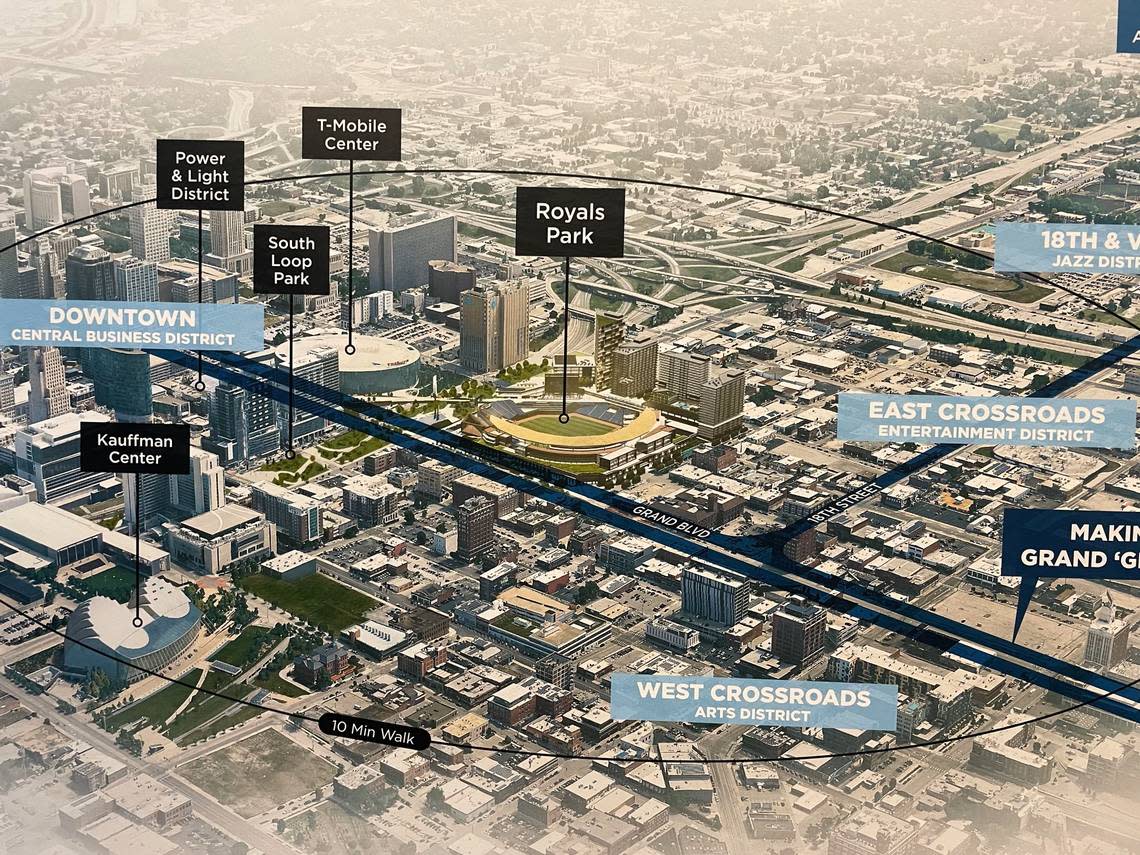
According to the renderings, home plate would be near the current corner of 16th and McGee streets. The imagined $1 billion-plus ballpark would be bordered on the east by office, retail and residential development, which would be a potential source of revenue for the team. To the north, the South Loop freeway park over Interstate 670, which is now planned to cap the four blocks west of Grand Boulevard, would be extended three blocks further to the east. A pedestrian walkway would extend between the stadium and the arena.
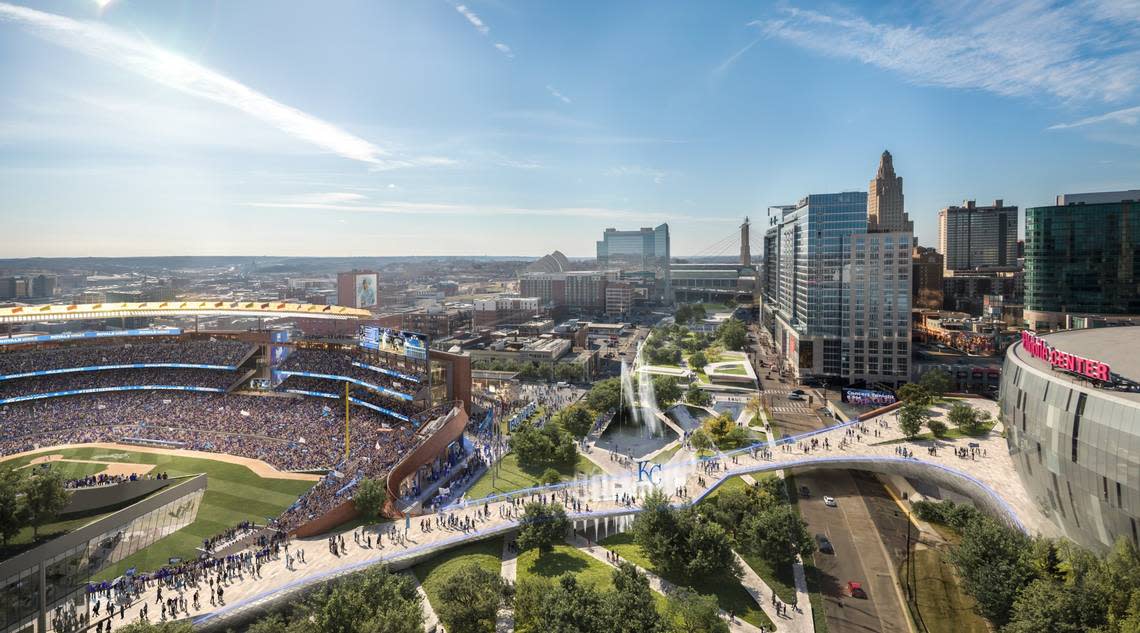
“We’re thrilled to announce our plans to contribute community dynamics and incredible fan and stadium experience and long term growth to the Crossroads,” Sherman said at an afternoon news conference crowded with members of the media and community leaders at Kauffman Stadium. “A neighborhood ballpark home for the Royals that will stand strong for the next 50 years here in Jackson County.”
He said he and others would work hard to convince the community that the Royals need a new home to replace much-beloved Kauffman, and that the Crossroads site is one deserving of continued support from county taxpayers, who will decide on April 2 whether to subsidize a new ballpark.
“We know we have to earn and win every vote,” he said in an acknowledgment that many of the team’s fans would prefer that the Royals remain at Kauffman.
The team’s billionaire owner then turned things over to Earl Santee, the CEO and founder of Populous, the global sports architecture firm based in Kansas City, which the Royals have hired to design that proposed new ballpark.
He underscored his belief that Kauffman is worn out and in need of replacement, calling renovation of The K “not feasible” and “not realistic.” Then he addressed widely held concerns about the availability of parking for a downtown ballpark. The new stadium, he said, would be within a 10-minute walk of 40,000 parking spaces, compared to the 26,000 at the Truman Sports Complex, where the Royals have played at Kauffman Stadium for a half century.
Hence: no need to build more parking lots, Santee said.
Another of the site’s attributes, out of the 14 or 15 sites initially considered for a new ballpark, this one has the most access already and will not require alterations to the existing highways, team officials said.

Santee said there are 22 potential ways for fans to get to it thanks to the many freeway loop exits and public transit.
“If I had to compare it to other sites I’ve seen, this is by far the most accessible site we have in Major League Baseball,” he said.
But several key questions remain as Jackson County’s April 2 election approaches, when voters will decide on a tax to help fund the new stadium. Such as, who would pay for that extension of the highway lid park?
The Royals aren’t sure.
How much will the team be investing in the ballpark? About $1 billion of a $2 billion project that includes the surrounding private development.
Where the rest of the funding is coming from beyond the potential county sales tax that hinges on that April election went unexplained at an afternoon news conference at Kauffman Stadium.
The team says its contribution to the construction of a new stadium seating 34,000 — smaller than the seating capacity at The K — would be the land underneath it.
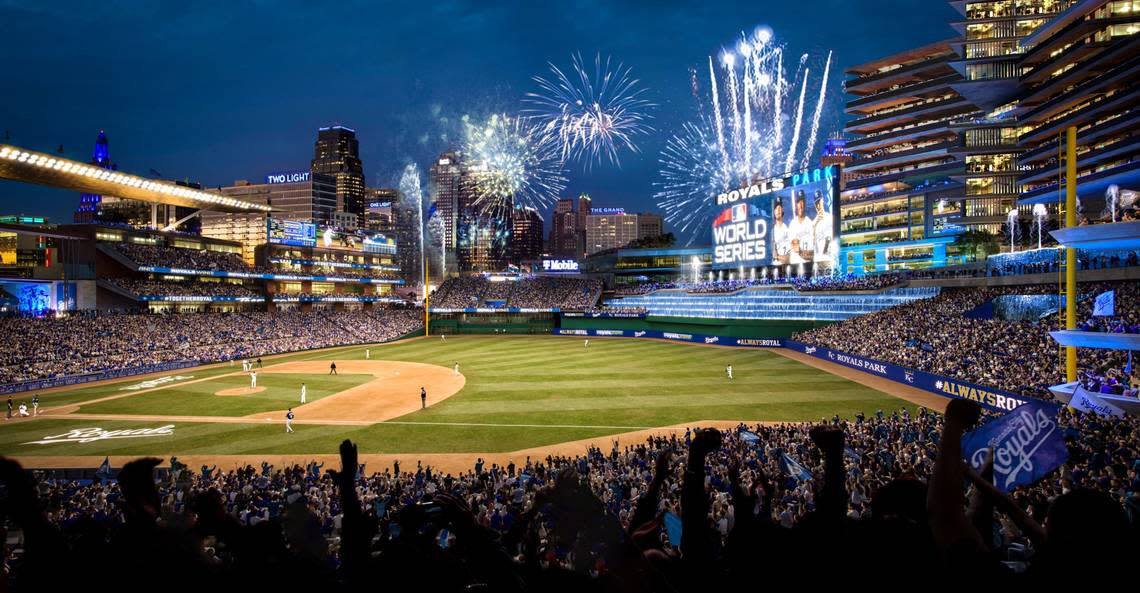
Brooks Sherman, the team’s president of business operations and not related to the team owner, said the Royals would buy the property and convey it to Jackson County, which would own the stadium.
The team also intends to buy the land on the blocks surrounding the planned ballpark. But he and another team official left unclear what would happen if some property owners were unwilling to sell.
Negotiations are ongoing with some of those property owners now, but no firm commitments have been made.
“We want to be good neighbors,” Sherman said to describe the team’s approach in those negotiations.

What will voters decide?
Jackson County voters will decide on April 2 whether to approve a new, 3/8th-cent sales tax to be collected over 40 years to help pay for a new Royals ballpark in the Crossroads and renovations at Arrowhead Stadium for the Chiefs.
It would replace the current sales tax that voters approved in 2006 to fund renovations at both Kauffman and Arrowhead. That tax is set to end in the fall of 2031, several months after the teams’ current leases expire at the Truman Sports Complex.
The county legislature put the tax measure on the ballot before the Royals had committed to a site and before the county had signed agreements or leases from either team that spell out the details of where the rest of the money will come from for those projects. Brooks Sherman said negotiations are progressing.
The teams have promised to reach those agreements with the county by the end of this month. Both teams signed letters of intent that spell out the broad parameters of what will be in those contracts.
Back in 2006, the county legislature waited until after the leases were signed to put the sales tax measure on the ballot.
The county issued $425 million in bonds, with the money to be split evenly to help pay for each team’s project. The Royals agreed to spend an additional $25 million, while the Chiefs spent $125 million.
The county is still paying those bonds off. Under the current lease, tax proceeds collected that exceed annual debt payments go to the teams. They split that $20 million a year to pay for repairs, maintenance, management and some operations at the stadiums.
Since 2007, the county has spent $700 million on the stadiums and is projected to still owe about $200 million.
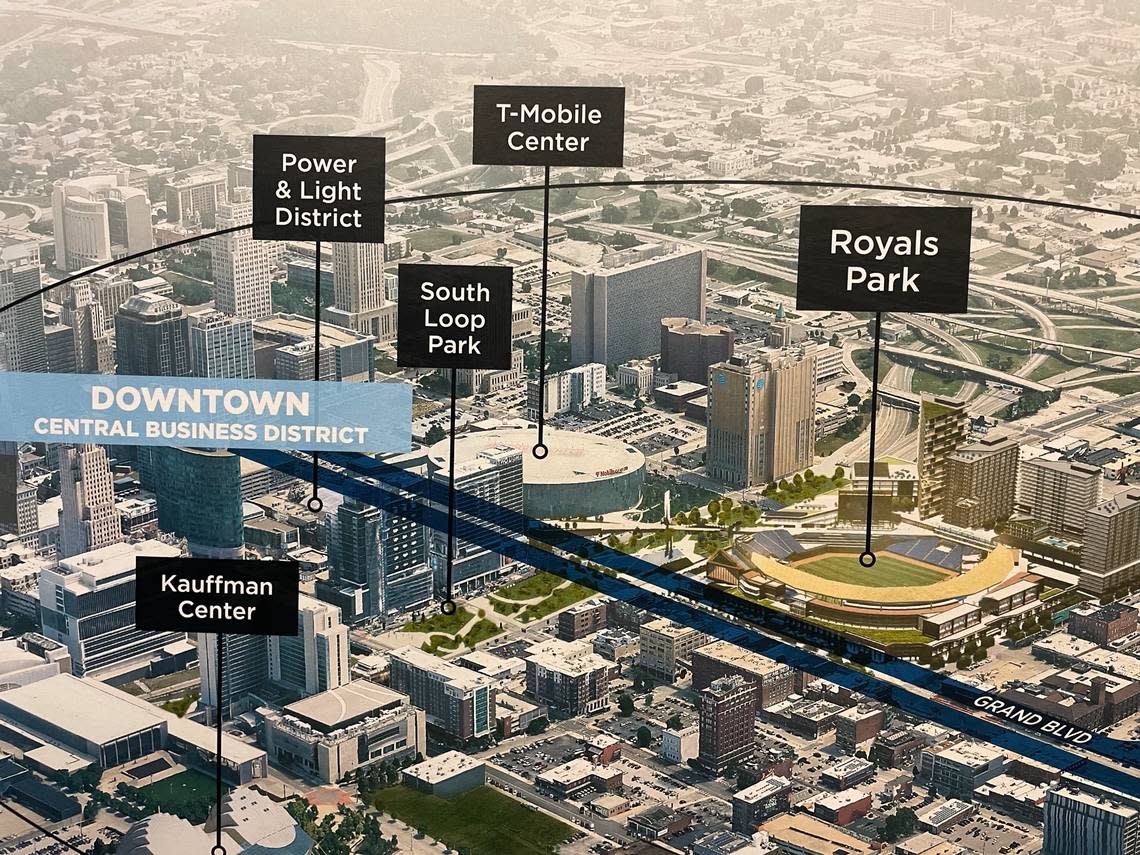
What else do we know about the site?
The current owner of the iconic Star building, which would be demolished, has been eager to sell. Built for $200 million, the Star’s former printing plant and distribution center at 1601 McGee Street known as the Press Pavilion opened in 2006.
But financial pressures affecting the entire newspaper industry prompted The Star’s publicly traded parent company at the time, McClatchy, to sell the 424,000-square-foot building in 2019 to Ambassador Hospitality LLC for $30 million.
The building has been vacant since The Star’s news and business operations moved out of the press pavilion at the end of 2021 and later into another office space near downtown.
City land records show that 18 real estate parcels belonging to 13 separate owners make up the two blocks immediately to the west of the former Star building between McGee Street and Grand Boulevard, 17th Street to Truman Road.
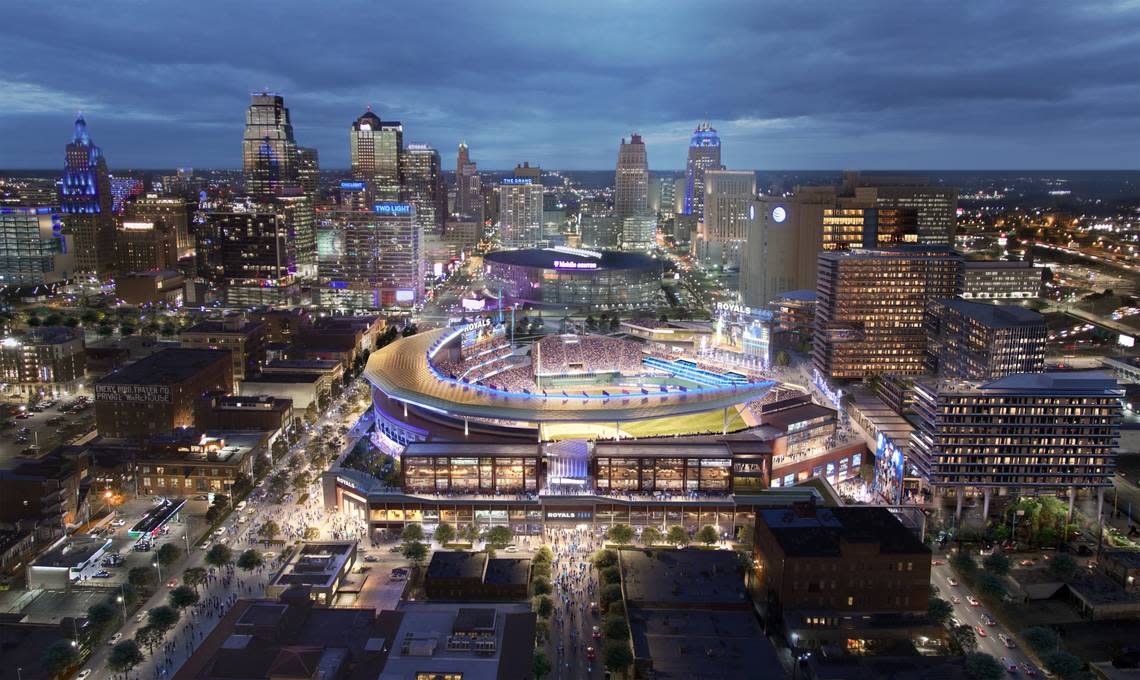
The downtown congregation of Leawood-based Resurrection Church – formerly The United Methodist Church of the Resurrection – owns the entire block from 17th to 16th streets. The block to the north includes a few restaurants, the site of a former tattoo parlor and a topless juice bar with a neon sign above it that screams “Totally Nude.”
The church at 1601 Grand Boulevard recently announced plans to start construction of a $2.8 million expansion to the building it opened in 2018.
After Tuesday’s announcement, the church issued a news release saying it planned to maintain a presence downtown and preferably in the Crossroads, no matter what happens.
“Our location reflects our love for downtown Kansas City and the Crossroads and our desire to have a positive impact in the heart of our city.” the statement said. “In the days ahead, we will continue to be in conversation with the Royals. We are committed to being in the Crossroads and downtown Kansas City and to have a positive impact for generations to come.”
The two blocks to the east of the former printing plant has 20 parcels, with 12 owners, including local restaurants and bars.
“I’ve been a regular in this neighborhood for 25 years,” said Mat Adkins, owner of The Pairing, a boutique liquor shop at 1615 Oak St., which is inside the proposed stadium site. “This will completely change the culture of creativity that so many people have built over that period. This is one of the only neighborhoods left in KC that’s almost exclusively locally owned and operated and full of independent businesses. Dropping a big baseball stadium in the middle of it changes everything.”
The Star’s David Hudnall contributed reporting.
